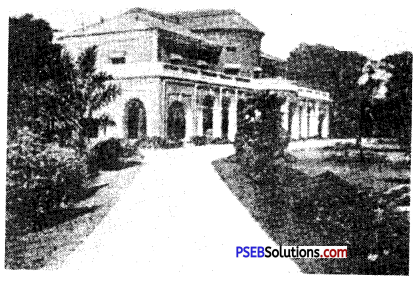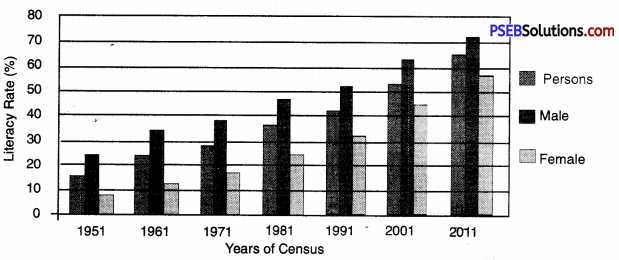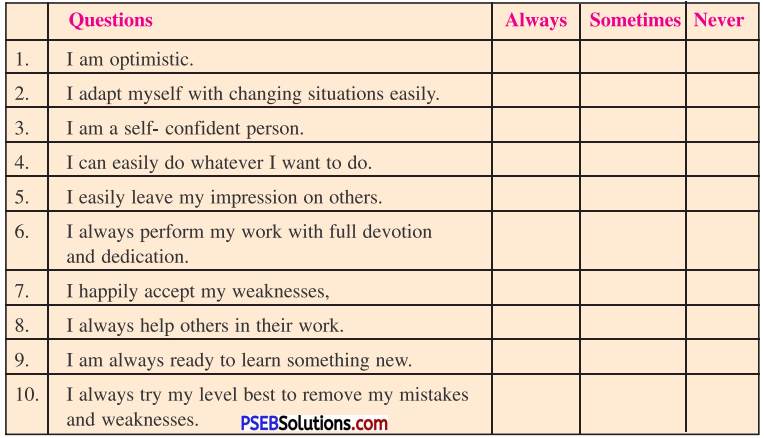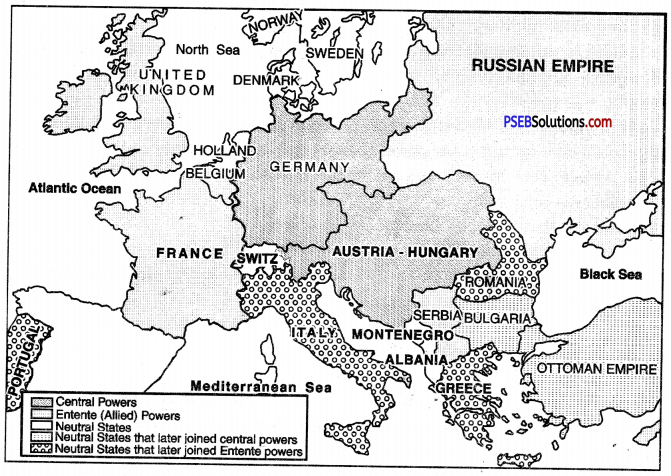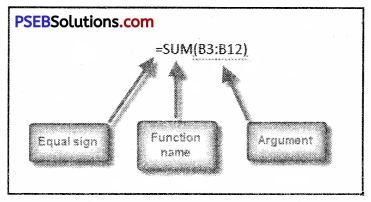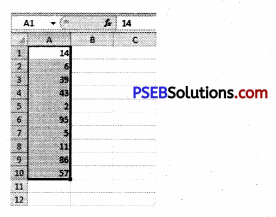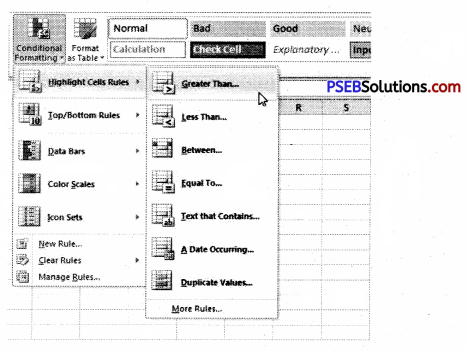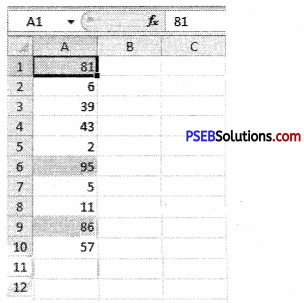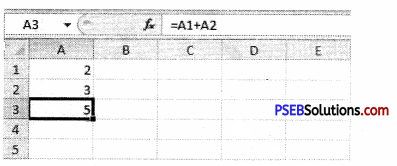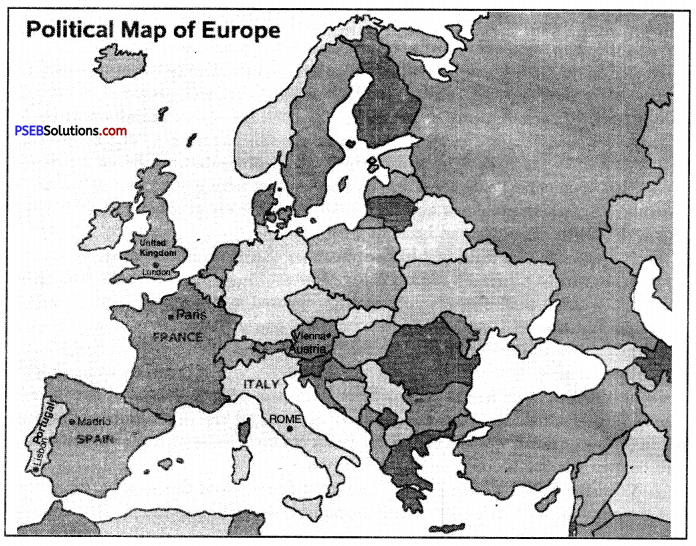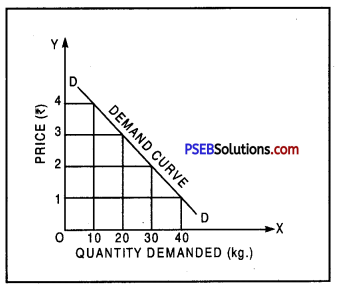Punjab State Board PSEB 9th Class Agriculture Book Solutions Chapter 1 Kharif Crops Textbook Exercise Questions and Answers.
PSEB Solutions for Class 9 Agriculture Chapter 1 Kharif Crops
Agriculture Guide for Class 9 PSEB Kharif Crops Textbook Questions and Answers
(A) Answer in one-two words:
Question 1.
Name two Kharif bowls of cereal.
Answer:
Paddy, Maize, Jowar.
Question 2.
Name two important varieties of rice.
Answer:
P.R.-123, P.R.-122.
Question 3.
Give seed requirement of desi cotton hybrid for one acre.
Answer:
1.5 kg seed per acre.

Question 4.
Name one major insect pest of maize.
Answer:
Maize borer
Question 5.
Name two diseases of sugarcane?
Answer:
Red rot, Red stripe, wilt, etc.
Question 6.
Name two Pulse crops.
Answer:
Moong, Mash, Arhar.
Question 7.
Give seed rate of maize for one acre.
Answer:
It is 7 kg for pearl popcorn and 8 kg per acre for other varieties. For fodder crop, it is 30 kg per acre.
Question 8.
Give sowing time of cotton.
Answer:
1 April to 15 May.
Question 9.
Name one intercrop in sugarcane.
Answer:
Summer Moong or Summer Mash.
Question 10.
Name two fodder crops.
Answer:
Maize, Bajra, Guara.
(B) Answer In one-two sentence:
Question 1.
What is crop rotation?
Answer:
Different types of crops which are sown in a sequence in the field in one year is called crop rotation, e.g. Paddy-wheat, Paddy- Potato-Sunflower, etc.

Question 2.
Name two rice-based crop rotations.
Answer:
Rice-wheat/Berseem, Rice-wheat-sathi maize/sathi moong. Rice-Potato-Sathi Moong/Sunflower.
Question 3.
What are the deficiency symptoms of zinc in rice?
Answer:
Due to the deficiency of zinc, seedlings remain stunted and tillerless. Lower leaves become rusty, near the base. The central vein of leaves changes color and leaves ultimately dry up. To avoid and control this malady, apply 25 kg zinc sulfate per acre at the time of puddling.
Question 4.
Write sowing method of maize.
Answer:
Maize is sown from the last week of May to the end of June, can be sown in the second fortnight of August. Row spacing should be 60 cm and plant spacing should be 20 cm. Use 7 kg seed per acre for pearl popcorn and 8 kg for other varieties.
Question 5.
Give control of Its in Maize.
Answer:
It’s can be controlled by using Atrataf within 10 days of sowing.
Question 6.
Why puddling is done in Paddy?
Answer:
Paddy needs a lot of water. Due to puddling, the water holding capacity of the field increases to a large extent. The rate of evaporation of water is decreased. It also helps to prevent the growth of weeds. Transplanting, of paddy, becomes easy.
Question 7.
Give seed requirement of sugarcane.
Answer:
The seed rate for cane crops is twenty thousand, three budded sets or four budded sets 15 thousand, or five budded sets-12 thousand for one acre.

Question 8.
Write time and method of sowing for Autumn sugarcane.
Answer:
Autumn sugarcane is sown from 20 September to 20 October and sowing is done in rows with a spacing of 90 cm.
Question 9.
Give the method of defoliation in moong for combined harvesting.
Answer:
If combine is to be used to harvest the Moong crop, then at the time when 80% of pods are mature, Gramoxone is sprayed to make the leaves and stem dry i.e. for defoliation.
Question 10.
Write method of weed control in rice.
Answer:
Swank and Motha weeds grow in rice. Hoeing should be done twice manually by hands, use paddy weeder for inter-culture. After 15 and 30 days of transplanting pull out the weeds from the fields. Suitable herbicides should be used at the proper time in the required amounts. Herbicides that can be used are Machete, Refit, Top- star, Arozin, etc. use Algrip for a gorilla, Sanni, etc.
(C) Answer in five-six sentences:
Question 1.
Discuss the use of fertilizers in rice.
Answer:
The fertilizer requirement for rice for an acre is 50 kg nitrogen, 12 kg phosphorus, and 12. kg potassium. Potassium dose should be applied on a soil test basis. Divide nitrogen dose into three parts. Apply one part of nitrogen and a whole of phosphorus and potassium (if needed) before the last puddling. The remaining two parts of nitrogen are broadcasted in two equal splits at three and six weeks after transplanting. If rice is sown after wheat which had received a recommended supply of phosphorus, then there is no need to apply phosphorus for rice crops.
Question 2.
Explain direct seeding of rice.
Answer:
Rice should be sown directly in only medium to heavy soils. In light (sandy) soils there occurs deficiency of iron in the crop and the yield is reduced.
Time of sowing: Suitable time for direct sowing is the first fortnight of June.
Seed rate: Seed requirement is 8-10 kg per acre.
The depth and row spacing: Seed should be sown at a depth of 2-3 cm using a paddy drill and row spacing should be 20 cm. Early maturing variety of Paddy should be used for direct sowing.
Weed control: Use stomp within 2 days of sowing. If after 30 days of sowing, swank, and motha are seen in the crop then use nominee gold. Segment herbicide is used to control broadleaf weeds.
Fertilizers: Apply 60 kg nitrogen per acre in three equal splits. Broadcast nitrogen after two, five, and nine weeks of sowing.
Irrigation: Keep watering the crop at 5-10 days intervals.

Question 3.
Give details of seed treatment in cotton.
Answer:
Seed rate for B.T. varieties is 750 grams, for non-B.T. hybrid varieties 1 kg, for normal varieties 3 kg, for desi cotton varieties it is 1.5 kg and for simple varieties, it is 3 kg per acre. Use the adviced chemicals for seed treatment. For prevention from Jassid use Gaucho or Cruiser.
Question 4.
Discuss preventive measures for lodging in sugarcane.
Answer:
We should make efforts to prevent the lodging of sugarcane crops because frost has a bad effect on fallen crops. To prevent lodging, we should earth up heavily the crop before the outset of monsoon, nearly the end of June. Prop the crop at the end of August or at the beginning of September.
Question 5.
For which crops and why sulfur is essential?
Answer:
Sulfur is essential for oilseed crops. Single superphosphate is used as a source of phosphorus because it contains sulfur also. If this fertilizer is not available, use gypsum as a source of sulfur.
Very Short Answer Type Questions:
Question 1.
What is the time of sowing for the Kharif (Sawani) crop?
Answer:
June-July or in Monsoon.
Question 2.
When is Sawant or Kharif crop harvested?
Answer:
In October-November.
Question 3.
How can you categorize the Kharif crop?
Answer:
Three categories of Kharif crops :
- Cereals
- Pulses and Oilseed crops
- Cotton, Sugarcane, and fodder.
Question 4.
Name Kharif cereal crops.
Answer:
Paddy, Basmati, Maize, Bajra (Sorghum).

Question 5.
Which country is the highest producer of Paddy?
Answer:
China
Question 6.
Which state of India is the highest producer of Paddy?
Answer:
West Bengal.
Question 7.
What is another name for Paddy?
Answer:
Rice and Jeeri, Dhaan, Jhonna.
Question 8.
How much area is occupied by Paddy crop in Punjab?
Answer:
28 lakh hectare.
Question 9.
How much is the average yield of Paddy in Punjab?
Answer:
60 quintal per hectare.
Question 10.
Which Karqha is used to level the field before Puddling it for the Paddy crop?
Answer:
Laser Karahd.
Question 11.
What is the seed rate for Paddy?
Answer:
It is 8 kg per acre.
Question 12.
Which chemical is used to control broadleaf weed like Gorilla in Paddy?
Answer:
Algeria or Segment.
Question 13.
Which device is used to save water for irrigation of Paddy crop?
Answer:
Tensiometer.
Question 14.
What type of soil is suitable for direct sowing of paddy?
Answer:
Medium to heavy soil.
Question 15.
What is used if there is a deficiency of zinc in Paddy and what is its quantity used?
Answer:
Zinc sulfate, 25 kg per acre.
Question 16.
What should be the moisture content for storing rice in godowns?
Answer:
12%,
Question 17.
Name varieties of Basmati.
Answer:
Punjab Basmati-3, Pusa Punjab Basmati-1509, Pusa Punjab Basmati-1121.
Question 18.
What is the time of sowing, for raising the nursery of Paddy?
Answer:
Nursery sowing for Pusa Punjab Basmati-1509 is done in the second fortnight of June and for other varieties, it is done in the first fortnight of June.
Question 19.
What happens to Paddy if excess nitrogen is applied to it? (high doses of nitrogen)
Answer:
It causes excessive vegetative growth and plants attain more height. This causes lodging of the crop and yield is reduced.
Question 20.
Which country is the highest producer of maize?
Answer:
The United States of America.

Question 21.
Which state of India is the highest producer of maize?
Answer:
Andhra Pradesh.
Question 22.
How much area of land is occupied by maize crop in Punjab?
Answer:
1 lakh 25 thousand hectares.
Question 23.
What is the average yield of maize in Punjab?
Answer:
15 quintals per acre.
Question 25.
How much rain is suitable for maize?
Answer:
50 to 75 cm.
Question 25.
What type of soil is suitable for maize?
Answer:
Well-drained medium to heavy (loam and silty loam).
Question 26.
Give seed rate for Pearl popcorn (maize variety).
Answer:
7 kg per acre.
Question 27.
Give varieties of maize for normal use.
Answer:
PMH-1, PMH-2.
Question 28.
Name special purpose varieties of maize.
Answer:
Punjab sweet corn-1, Pearl popcorn.
Question 29.
What is the time of sowing for maize?
Answer:
Maize can be sowed from the last week of May to the end of June and in the second fortnight of August.
Question 30.
What are row spacing and plant spacing for maize crops?
Answer:
60 cm, 22 cm.
Question 31.
Which weedicide is more effective for Its in maize?
Answer:
Strata.
Question 32.
What is sown in the Helds of maize crop to prevent weeds?
Answer:
Rawang (grams).
Question 33.
Which herbicide is used to control dila/motha (common sedge)?
Answer:
2, 4-D.

Question 34.
How much irrigation is required for normal maize?
Answer:
4-6 irrigations are needed.
Question 35.
Which state in India is the highest producer of pulses?
Answer:
Rajasthan.
Question 36.
How much area is occupied by Moong crop in Punjab?
Answer:
5 thousand hectares.
Question 37.
What is the yield of Moong in Punjab?
Answer:
350 kg per acre.
Question 38.
Which type of soil is not suitable for Moong?
Answer:
Saline-alkaline or waterlogged soils are not suitable.
Question 39.
What is the seed rate for Moong?
Answer:
8 kg per acre.
Question 40.
Give the time of sowing for Moong,
Answer:
The first fortnight of July.
Question 41.
What are row spacing and plant spacing for moong crop?
Answer:
Row spacing is 30 cm and plant spacing is 10 cm.
Question 42.
Which herbicides are used to control weeds in Moong?
Answer:
Treflan or Basalin.
Question 43.
How much land is occupied by the Mash crop in Punjab?
Answer:
2 thousand hectares.
Question 44.
What is the average yield of Mash in Punjab?
Answer:
180 kg acre.
Question 45.
Which soil is not suitable for the Mash crop?
Answer:
Saline-alkaline or water-logged soils.
Question 46.
What is the seed rate for Mash?
Answer:
6-8 kg per acre.

Question 47.
What is the time of sowing of Mash in the Sub-mountainous region?
Answer:
15 to 25 July.
Question 48.
What is a time of sowing of Mash in regions other than the Sub-mountainous region?
Answer:
Last week of June to the first week of July.
Question 49.
What is row spacing for Mash?
Answer:
30 cm.
Question 50.
Which pesticide is used in Mash?
Answer:
Stomp.
Question 51.
Which country is the highest producer of Soyabean?
Answer:
The United States of America.
Question 52.
Which state of India is the highest producer of Soyabean?
Answer:
Madhya Pradesh.
Question 53.
Give Soyabean based crop rotation cycle.
Answer:
Soybean—Wheat/Barley.
Question 54.
Name varieties of Soyabean.
Answer:
SL-958, S.L.-744.
Question 55.
Give the time of sowing for Soyabean.
Answer:
First fortnight of June.
Question 56.
What is row spacing for Soyabean?
Answer:
45 cm.
Question 57.
Which herbicide is used to control weeds in Soyabean?
Answer:
Stomp, primate.
Question 58.
Name insects/pests which attack Soyabean?
Answer:
Hairy caterpillar and whitefly.
Question 59.
Which crop is a pulse as well as oilseed?
Answer:
Soybean.
Question 60.
Which country in the world is the highest producer of oilseed?
Answer:
The United States of America.

Question 61.
Which state in India is the highest producer of oilseeds?
Answer:
Rajasthan.
Question 62.
Which country in the world is the highest producer of groundnut?
Answer:
China.
Question 63.
Which the State Of India is the highest producer of groundnut?
Answer:
Gujarat.
Question 64.
How much area is occupied by groundnut in Punjab?
Answer:
15 thousand hectares.
Question 65.
Give average yield of groundnut in Punjab.
Answer:
7 kg per acre.
Question 66.
Name a crop rotation cycle involving groundnut.
Answer:
Groundnut-wheat.
Question 67.
Name varieties of groundnut.
Answer:
S.G.-91, S.G.-84.
Question 68.
Give seed rate for groundnut.
Answer:
38-40 kg seed (Kernel) per acre.

Question 69.
What is the time of sowing for rainfed groundnut?
Answer:
With the advent of the monsoon.
Question 70.
What is the time of sowing for irrigated groundnut crops?
Answer:
From end April to end May.
Question 71.
Which herbicides are used to control weeds in groundnut?
Answer:
Treflan, Stomp.
Question 72.
Name Kharif fodder crops.
Answer:
Maize, Jowar, Bajra.
Question 73.
Which country in the world is the highest producer of cotton?
Answer:
China.
Question 74.
Which state of India is the highest producer of cotton?
Answer:
Gujarat.
Question 75.
How much area is under the cotton crop?
Answer:
5 lakh hectare.
Question 76.
What is the average yield of cotton in Punjab?
Answer:
230 kg lint per acre.
Question 77.
Which type of soil is not suitable for cotton?
Answer:
Sandy, saline, or water-logged.
Question 78.
Give normal varieties of cotton.
Answer:
L.H.-2108.
Question 79.
Give seed rate for BT cotton.
Answer:
750 gram per acre.
Question 80.
Name a hybrid variety of desi cotton.
Answer:
PAU 626 H.
Question 81.
Give the time of sowing for cotton.
Answer:
1 April to 15 May.
Question 82.
Give row spacing for cotton.
Answer:
67 cm.
Question 83.
Name herbicides used to control weeds in cotton.
Answer:
Treflan, stomp, gramoxon, Roundup.
Question 84.
Which country is the highest producer of Sugarcane?
Answer:
Brazil.
Question 85.
Which state in India is the highest producer of Sugarcane?
Answer:
Uttar Pradesh.
Question 86.
How much area is occupied by sugarcane crop in Punjab?
Answer:
80 thousand hectares.
Question 87.
What is the average yield of sugarcane in Punjab?
Answer:
280 quintals per acre.
Question 88.
How much sugar is obtained from sugarcane?
Answer:
9%.
Question 89.
What type of soil is suitable for sugarcane?
Answer:
Medium to heavy soil.
Question 90.
Name early maturing varieties of spring cane.
Answer:
CoJ-85, CoJ-83.
Question 91.
What is the seed rate if four budded sets are used for a cane?
Answer:
15 thousand per acre.
Question 92.
What is the seed rate for the cane on the basis of weight?
Answer:
30 to 35 quintals per acre.
Question 93.
What is the time of sowing for a cane?
Answer:
Mid-February to end March.
Question 94.
Name herbicides to control weeds in cane crops.
Answer:
Strata, Senior.
Question 95.
Name varieties of Autumn cane.
Answer:
CoJ-85, CoJ-83.

Question 96.
What is a time of sowing for an autumn cane?
Answer:
20 September to 20 October.
Question 97.
Which weedicide should be used if Raya or wheat is intercropped in the autumn cane?
Answer:
Isoproturon.
Question 98.
Which herbicide is used in cane crop if summer moong and summer mash is intercropped?
Answer:
Stomp.
Question 99.
How much green fodder is required for an adult animal per day?
Answer:
40 kg green fodder.
Question 100.
Name Kharif fodder crop.
Answer:
Bajra, Maize, Jowar, Napier Bajra, Guniea Grass, Guara, etc.
Question 101.
How many days, Maize, Kharif fodder take to become available for harvesting?
Answer:
50-60 days.
Question 102.
Name the variety of maize, a Kharif fodder.
Answer:
J-1006.
Question 103.
What is the time of sowing for fodder maize?
Answer:
The first week of March to mid-September.
Question 104.
Which pest attacks the fodder maize?
Answer:
Maize borer.
Question 105.
Which fodder is liked by animals?
Answer:
Jowar.
Question 106.
Name varieties of Jowar?
Answer:
S.L. 104.
Question 107.
What is the sed rate of Jowar?
Answer:
20-25 kg per acre.
Question 108.
What is the time of sowing for early maturing Jowar?
Answer:
Mid-March.
Question 109.
What is a suitable time for sowing for Jowar?
Answer:
Mid-June to middle July.
Question 110.
What is row spacing for Jowar?
Answer:
22 cm.

Question 111.
If a mixture of Guara and Jowar are sown together which herbicide is used ?
Answer:
Stomp.
Question 112.
Write time of harvesting of Jowar?
Answer:
65-80 days, from boot to milk stage.
Question 113.
Give crop rotation cycle consisting of Bajra.
Answer:
Bajra-Maize-Bersem.
Question 114.
Give varieties of Bajra.
Answer:
PHBF-1, FBC-16.
Question 115.
Give seed rate for Bajra.
Answer:
6-8 kg seed per acre.
Question 116.
Give the time of sowing for Bajra.
Answer:
March to August.
Question 117.
What is the method of sowing for Bajra?
Answer:
Bajra is sown by the broadcasting method.
Question 118.
Which herbicide is used to control weeds in Bajra?
Answer:
Atrataf.
Question 119.
What do you know about the irrigation of Bajra?
Answer:
Normally 2-3 irrigations are required.
Question 120.
After how many days Bajra is harvested?
Answer:
After 45-55 days.
Question 121.
Give diseases of Bajra.
Answer:
Green ear, grain smut.
Question 122.
Write insects pest which attacks Bajra.
Answer:
Root bug, grasshopper.

Short Answer Type Questions:
Question 1.
Give details of climate and soil for cultivating Paddy.
Answer:
Paddy needs high temperature, excess moisture and excess of water. Medium to heavy soil is suitable. It can also grow in alkaline and acidic soil.
Question 2.
Give details of seed rate and seed treatment for paddy.
Answer:
8 kg seed per acre is needed for raising the nursery. To save crops from disease, seeds should be treated with recommended fungicides, soak the seed for 8 to 10 hours in recommended chemicals.
Question 3.
How will you control broadleaf weeds in Paddy?
Answer:
Broadleaf weeds like Gorilla, sunny etc. grow in paddy. Use Algrip or segment after 15-20 days of transplanting.
Question 4.
Why is green manure used?
Answer:
Leguminous plants are used for green manure e.g. Pulse crops, Sunhump, dhaincha, etc. These crops help in the fixation of nitrogen in the soil. Green manure crop is cultivated and it is mixed into the soil of the field. This helps in the increasing of humus and- makes the soil more fertile.
Question 5.
Discuss the harvesting and storing of Paddy.
Answer:
The crop can be harvested when ears are nearly ripe and the straws change color to yellow. Produce can be stored in godown when the moisture content is not more than 12%.
Question 6.
Give the time of nursery sowing for Basmati.
Answer:
For Pusa Punjab Basmati 1509, the time of nursery sowing is the second fortnight of June and for Punjab Basmati-3 and Pusa Basmati-1121, it is the first fortnight of June.
Question 7.
What is the time of transplanting seedlings of Basmati?
Answer:
For Pusa Punjab Basmati-1509, the time of transplanting is the second fortnight of July and for Punjab Basmati-3 and Pusa Basmati-1121, it is the first fortnight of July. Transplanting is done in a puddled field. Transplant 33 plants per square meter.

Question 8.
Give details about climate and soil for maize.
Answer:
Maize requires a moist and hot climate from germination to flowering. If there is less moisture and a very high temperature at the time of flowering, it may damage the foliage. This causes dryness (desiccate) of the pollen and proper pollination does not take place, it results in a poor grain setting. 50 cm to 75 cm rain is suitable for maize. Well-drained, medium to heavy soil is suitable.
Question 9.
What do you know about the irrigation of maize?
Answer:
Maize requires 4-6 irrigations, but it depends on the rainfall. Proper care should be taken to irrigate during the pre-tasselling and silking stages.
Question 10.
What do you know about harvesting Maize?
Answer:
When husk covers become dry and brown even when the stalks and leaves are somewhat green, the crop is ready to harvest. Moisture content should not be more than 15% in the grains.
Question 11.
What do you know about climate and soil for Moong?
Answer:
The hot climate is suitable for Moong. This crop can bear more heat and extra dryness as compared to other pulses. Saline and waterlogged soils are not suitable for this crop.
Question 12.
Give details of land preparation and- application fertilizers for Moong.
Answer:
Prepare the land by giving 2-3 ploughings and level the soil using plank. At the time of sowing apply 5 kg nitrogen a^id 16 kg of phosphorus by drilling.
Question 13.
Explain how to control weeds in Moong?
Answer:
To control weeds one or two hoeings should be done. Use Treflan or Basalin to control weeds before sowing. Use stomp within two days of sowing.
Question 14.
Discuss the harvesting of moong.
Answer:
When nearly 80% of pods are mature, moong can be harvested by using a sickle. Thresher can be used to thresh moong. If combined is to be used to harvest moong, spray gramophone to make leaves and stem dry when about 80% of pods are mature.
Question 15.
What do you know about climate and soil requirements for Mash?
Answer:
For this crop hot and moist climate is found to be suitable. Nearly all types of soils can be used to grow mash, but saline-alkaline or water-logged soil are not suitable for this crop.
Question 16.
What do you know about improved varieties, land preparation and control of weeds for Mash ?
Answer:
- Improved Varieties: Mash-114, Mash-338.
- Land preparation: Plough two or three times and then use Suhaga to leveler.
- Weed Control: Hoeing should be done after one month of sowing or use stomp within 2 days of sowing.
Question 17.
What is the time of sowing for Mash?
Answer:
The time of sowing for Mash in sub-mountainous regions is from 15 to 25 July and in other regions, it is the last week of June to the first week of July. The rainfed crop should be sown with the onset of the monsoon. Sowing should be in rows with spacing 30 cm.
Question 18.
What do you know about the irrigation and harvesting of Mash?
Answer:
- Irrigation: Normally Mash crop does not need irrigation. But in summer it needs irrigation.
- Harvesting: When leaves fall off and pods change color to greyish black, then crop fs ready to harvest.
Question 19.
What do you know about climate and soil for soybean?
Answer:
It needs a hot climate. It can be grown in all types of soils but well-drained, non-saline/alkaline, fertile soil is more suitable for its cultivation.

Question 20.
Write about improved varieties, crop rotation, and land preparation for soybean.
Answer:
- Crop rotation: Soyabean-Wheat/Barley.
- Improved varieties: S.L.-958, S.L.-744.
- Land preparation: Plough twice and use sugar for leveling.
Question 21.
Write about the seed rate, seed treatment, and method of sowing for Soyabean.
Answer:
The seed rate is 25-30 kg per acre. Treat the seed with recommended chemicals. If Soyabean is being sown for the first time, apply bacterial culture to the seeds. Row spacing should be 45 cm.
Question 22.
What do you know about weed control in Soyabean?
Answer:
Hoeing should be done twice to control weeds. Hoeings should be done after 20 and 40 days after sowing. Use stomp after 1-2 days of sowing or use primate after 15-20 days of sowing to control weeds.
Question 23.
Write about the fertilizer application for Soyabean.
Answer:
Apply 4 tonnes per acre of farmyard manure (FYM) before sowing Soyabean. Apply 13 kg nitrogen and 32 kg phosphorus per acre at the time of sowing.

Question 24.
Write about the irrigation of Soyabean.
Answer:
Soybean normally needs 3-4 irrigations. At the time of pod-filling, one irrigation is necessary. In case there is rain, then there is no need for irrigation.
Question 25.
What do you know about the harvesting of Soyabean?
Answer:
When all leaves fall off and pods change their color, crop is ready for harvesting. For storing, moisture content should not be more than 7%.
Question 26.
What do you know about insects/pests and diseases of Soyabean?
Answer:
Hairy caterpillar and whitefly attack Soyabean crop. The disease which affects the crop is the yellow mosaic virus.
Question 27.
What do you know about climate and soil for groundnut?
Answer:
For rainfed crops, nearly 50 cm of rain is a must in July, August, and September. Light to Medium type soils is suitable for groundnut.

Question 28.
Write about improved varieties, land preparation, and crop cycle for groundnut.
Answer:
- Improved varieties: S.G.-99, S.G.-84.
- Land preparation: Prepare the land by plowing it twice.
- Crop cycle: Groundnut-Rabi crops.
Question 29.
Write about seed rate, seed treatment method of sowing for groundnut.
Answer:
Use recommended chemicals for seed treatment. The seed rate is 38-40 kg seed (Kernels) per acre. Sow after Rauni in 30 x 15 cm spacing.
Question 30.
Write about the application of fertilizers in groundnut.
Answer:
Groundnut needs 6 kg nitrogen, 8 kg phosphorus, and 10 kg potash per acre. Potash should be applied after testing the soil. Use superphosphate for phosphorus. It has sulfur also which is necessary for oil seed crops. If phosphorus is not required then 50 kg Gypsum per acre should be applied.
Question 31.
Write about weed control in groundnut.
Answer:
Hoeing is done after 3 and 6 weeks. To control weeds spray stomp after two days of sowing or spray Treflan and sow the crop the same day.
Question 32.
Write about irrigation of groundnut.
Answer:
Depending on rain, groundnut requires 2 or 3 irrigations. If there is less rain then irrigate at the time of flowering. Apply one or two irrigations depending upon rain at the time of pod formation.
Question 33.
Write about harvesting (digging), insects/pests, and diseases of groundnut.
Answer:
- Digging of groundnut: Crop is ready to harvest when uniform yellowing of the leaves takes place and old leaves fell off.
- Insects/Pests and diseases: Hairy caterpillar, white grub, Aphid, etc. can attack the crop. Collar rot, Root-knot, and Tikka, etc. are its diseases.
Question 34.
Write about climate and soil for cotton.
Answer:
Cotton can grow well in hot and dry climates. Cotton can grow on all types of soil but saline, water-logged soil is not suitable.
Question 35.
Write about varieties of cotton and crop cycle.
Answer:
Crop Cycle (rotation) : Ahpos-wheat/Barley, Kapas- sunflower, Kapas-Raiya, cotton-senji/Barseem/oats.
Improved varieties
- B.T. Varieties—NSC-855, Ankur- 3028, MRC-7017, RCH-650.
- Non-B.T. hybrid—LH-144.
- Normal varieties—LH-2108.
- Desi hybrid varieties—PAU-626H.
- Desi Normal varieties—FDK-124, L.D.-694.
Question 36.
Write about seed rate and seed treatment.
Answer:
Seed rate: For one-acre seed rate is :
- B.T. cotton: 700 gram
- Non-B.T. hybrid cotton: 1 kg.
- Normal variety : 3 kg.
- Hybrid desi cotton: 1.5 kg.
- Desi Normal variety : 3 kg.
Seed should be treated with recommended chemicals. To save it from Jassid use Gaucho or cruiser.
Question 37.
Write about the time and method of sowing for cotton.
Answer:
Time: 1 April to 15 May.
Row spacing: 67 cm.
Plant spacing: For normal varieties, it is 60 cm. For BT and non-BT hybrid varieties, plant spacing is 75 cm. For desi cotton it is 45 cm, for desi cotton hybrid varieties, it is 60 cm.

Question 38.
Write about weed control in cotton.
Answer:
Hoeing is done to control weeds. 2 to 3 hoeings are enough. First time hoeing is done before first irrigation. We can use a cultivator attached to the tractor or can use a trial driven by a bullock. Its/chapatti, Madhana/Makra can be controlled by using Stefan before sowing or spray stomp within 24 hours of sowing and hoeing should be done after 45 days or use one of gramophone and round up and spray directly on weeds by using safety hood.
Question 39.
Write about fertilizer application for cotton.
Answer:
Normal varieties: 30 kg nitrogen and 12 kg phosphorus per acre.
B.T. and non-B.T. Ijybrid Varieties: Apply 60 kg nitrogen and 12 kg phosphorus per acre. Apply potash after testing the soil. Apply all amounts of phosphorus at the time of sowing and half nitrogen at the time of thinning and remaining nitrogen at the time of flowering.
Question 40.
Write about irrigation and picking of cotton.
Answer:
Cotton needs 4 to 6 irrigations depending upon rain. First irrigation is applied after 4 to 6 weeks of sowing and after that irrigation is applied at a gap of two or three weeks. Picking Pick clean and dry bolls within 15-20 days so as to get a proper price from the mandi.
Question 41.
Write about insects/pests of cotton.
Answer:
Insects/pests which can damage the crop are Aphid, Jassid, Millibug, Pink bollworm, Tobacco caterpillar, American bollworm, Whitefly, etc.
Question 42.
Which insects do not attack and which attack B.T. cotton?
Answer:
American Bollworm does not attack B.T. cotton because B.T. cotton is genetically modified by the insertion of genes from a bacteria, which produces a protein, which acts as a poison for the bollworm. Sucking Pests and Tobacco caterpillars can attack.
Question 43.
Write about climate and soil requirements for sugarcane.
Answer:
The hot climate is suitable for sugarcane, medium to heavy soil is suitable. This crop can bear saline and alkaline soil to some extent.

Question 44.
Write about improved varieties and crop rotation for spring sugarcane.
Answer:
Crop rotation—Paddy/Maize/Cotton-Raya-Sugarcane- Ratoon-Ratoon II-Wheat.
Improved varieties
- Early maturing—CoJ-85, CoJ-83,
- Mid season varieites—CoPB-91 and CoJ-88
- Late maturing—CoJ-89
Question 45.
Write about land preparation for soil.
Answer:
Four to six hoeings are required. Use sugar after every hoeing. Hoeing should be done up to a depth of 45-50 cm, this is beneficial for the crop since it breaks the hard layer under the soil. Water retention ability is increased. Roots can go deep.
Question 46.
Write about seed selection and seed rate on the basis of weight.
Answer:
Use the top two-thirds portion for sowing. Use 30 to 35 quintal per acre seeds on the basis of weight.
Question 47.
Write about time and method of sowing.
Answer:
Time of sowing—Mid February to end March.
Method of sowing—Plant in rows with spacing of 75 cm and give planking and then water it. One more irrigation should be applied after 4-5 days.
Question 48.
What do you know about inter-crops in SHgarcane?
Answer:
Between two rows of sugarcane, inter-crop a row of summer moong or mash. This way we can get an additional yield of 1 to 2 quintals per acre for these crops. These crops help in increasing the. fertility of the soil and also do not affect the cane yield.
Question 49.
What do you know about fertilizer application for cane crops?
Answer:
FYM (Farm Yard Manure)—Apply 8 tonnes of FYM per acre before 15 days of sowing.
Nitrogen Fertilizer—For plant crops apply 60 kg nitrogen and for Ratoon crops use 90 kg of nitrogen per acre.
Phosphorus fertilizer—Based on soil testing, if a deficiency of phosphorus is found, apply 12 kg phosphorus per acre.
The deficiency of Potash usually does not occur in Punjab.
Question 50.
Give the method to apply fertilizers for sugarcane?
Answer:
| Fertilizer |
Method to apply |
| Nitrogen |
- Apply the first half nitrogen dose with the first irrigation after germination to the planted crop.
- The remaining half dose is to be applied in May or June.
- Apply three doses in equal quantity to the ratoon crop in February, April, and May.
|
| Phosphorus |
- Apply full dose at the time of planting.
- Phosphorus is drilled rows at the time of cultivation in February.
|
Question 51.
Write about weed control in sugarcane.
Answer:
To control weeds, two three hoeings are required. We can spread trash between the cane rows to suppress weeds and conserve soil moisture. We can use Atrataf or sensor within two-three days of planting. For Climbing vel and Broadlife weeds use 2, 4-D. In case of summer Moong or summer Mash is sown in sugarcane then stomp herbicide should be used instead of above said herbicides.

Question 52.
Write about irrigation requirements for sugarcane.
Answer:
Climate is hot and dry from April to June. Therefore, irrigate the crop at intervals of 7-12 days. During winter, irrigation should be applied at monthly intervals.
Question 53.
Write improved varieties, time of sowing, and method of sowing for the autumn cane.
Answer:
- Improved varieties—CoJ-85, CoJ-83.
- Time of sowing—20th September to 20th October.
- Row spacing-—90 cm spacing.
Question 54.
Write about intercropping and weed control for the autumn cane.
Answer:
Intercropping. Potato, wheat, toria, cabbage, Raya, gobhi Sarson, gram, pea, radish, garlic etc. Weed control. If wheat or Raya is sown in cane use isoproturon and in case garlic is sown then apply stomp.
Question 55.
Write about the time of sowing and sowing method for fodder crop Maize.
Answer:
Time of sowing. From the first week of March to mid-September.
Row spacing—30 cm.
Question 56.
Write about fertilizer requirements for fodder crop maize.
Answer:
At the time of field, preparation applies 10 tonnes of farmyard manure per acre. Apply 23 kg nitrogen and 12 kg phosphorus per acre.
Question 57.
Write about weed control in fodder maize.
Answer:
Use Atrataf for controlling weeds. Apply within two days of sowing the crop. It can also be used when the crop is at the 2-3 leaves stage. In case of maize and cowpea are sewn together then stomp can be used within two days of sowing.
Question 58.
Write an improved variety of sorghum, field preparation, seed rate, and treatment of seed.
Answer:
Field preparation. One plowing using harrow and two ploughings with a cultivator followed by planting.
Improved variety. SL 44 Seed rate and treatment. 20-25 kg seeds per acre. Use recommended fungicides for the treatment of seeds.
Question 59.
How to control weeds in sorghum?
Answer:
Use Atrataf within two days of sowing. It is helpful in controlling seasonal weeds like its sit/chupati. I guara and sorghum are sown together stomp can be sprayed within two days of sowing.

Question 60.
Write about crop rotation, improved variety, field preparation for Bajra.
Answer:
- Crop rotation—Bajra—Maize-Berseem.
- Improved Varieties—PHBF 1, FBC 16
- Field preparation. 2-3 ploughings are needed.
Long Answer Type Questions:
Question 1.
Give details of agricultural practices for Bajra.
Answer:
Do it yourself.
Question 2. Write about nursery sowing of paddy.
Answer:
The optimum sowing time for the nursery is 15th to 30th May. At the time of field preparation mix 12-15 ton well rotten farmyard manure per acre. Fertilizers that are applied at the time of sowing are 12 kg nitrogen, 10 kg phosphorus, 13 kg zinc per acre. Treated seeds with recommended fungicides are spread on a thick layer of 7-8 cm wet gunny bags and are also covered by wet gunny bags. This helps in pre-germination. Keep the gunny bags wet by sprinkling water on them. Seeds germinate in 24 to 36 hours. Sow these germinated seeds by the broadcast method of sowing. The seed rate is 8 kg per acre for nursery raising. To prevent weeds use Butachlor or soft herbicide. After 15 days of sowing apply 12 kg nitrogen per acre. Seedlings are ready when they are 20-25 cm tall or have 6-7 leaves.
Question 3.
How to use a mechanical transplanter for transplanting rice?
Answer:
This is a new technique to transplant rice. For this purpose, the nursery is grown on perforated polythene sheets which are of the size of the transplanter frames. Iron frames are placed over it and soil is filled in the frames up to the top surface. Pre-germinated seeds are spread on this soil in the frames and are covered with a thin layer of soil. Sprinkle water on the soil. The frame is lifted carefully and the required number of -such mats are prepared by the same procedure. Mats are kept wet by sprinkling water on a daily basis. For 200 mats nearly 10-12 kg seed is required, which are needed for transplanting for one acre.
Question 4.
Write about the cultivation of rice (Basmati).
Answer:
Do it yourself.
Question 5.
Write about the cultivation of Maize.
Answer:
Do it yourself.
Question 6.
Write about the cultivation of Moong.
Answer:
Do it yourself.
Question 7.
Write about the cultivation of Mash.
Answer:
Do it yourself.
PSEB 9th Class Agriculture Guide Kharif Crops Important Questions and Answers
Multiple Choice Questions:
1. Kharif cereal crops are :
(a) Maize
(b) Rice
(c) Sorghum
(d) All correct
Answer:
(d) All correct
2. Time of sowing for cotton is :
(a) 1 April to 15 May
(b) 1 January to 15 January
(c) December
(d) June
Answer:
(a) 1 April to 15 May

3. Seed rate for pearl popcorn is :
(a) 7 kg per acre
(b) 20 kg per acre
(c) 25 kg per acre
(d) None
Answer:
(a) 7 kg per acre
4. Time of harvesting of Kharif crop is :
(a) January-February
(b) October-November
(c) April-May
(d) Whenever
5. State which is at the top position in India in the production of pulses is :
(a) Himachal Pradesh
(b) Rajasthan
(c) Punjab
(d) Gujarat.
Answer:
(b) Rajasthan
True/False:
1. Varieties of Basmati rice are Punjab basmati-3, Pusa Punjab basmati-1509, Pusa basmati-1121.
Answer:
True
2. In the production of Maize, the United States of America is at the top position in the world whereas Andhra Pradesh is at the top position in India.
Answer:
True
3. Moong requires a cold climate.
Answer:
False
4. Soyabean belongs to both pulses as well as oilseed categories.
Answer:
True
5. Disease which can affect Soyabean yellow mosaic virus.
Answer:
True

Fill in the Blanks:
1. Harvest the Moong crop when about ………………. are mature.
Answer:
80% of pods
2. Maize needs an environment which is considerable……………….. from the germination to flowering.
Answer:
moist and warm
3. Soyabean requires ………….. climate.
Answer:
warm
4. High doses of …………… application to basmati should be avoided.
Answer:
nitrogen
5. Seed rate for Soyabean is …………… seed per acre.
Answer:
25-30 kg
![]()
![]()
![]()


![]()



![]()
![]()
![]()

